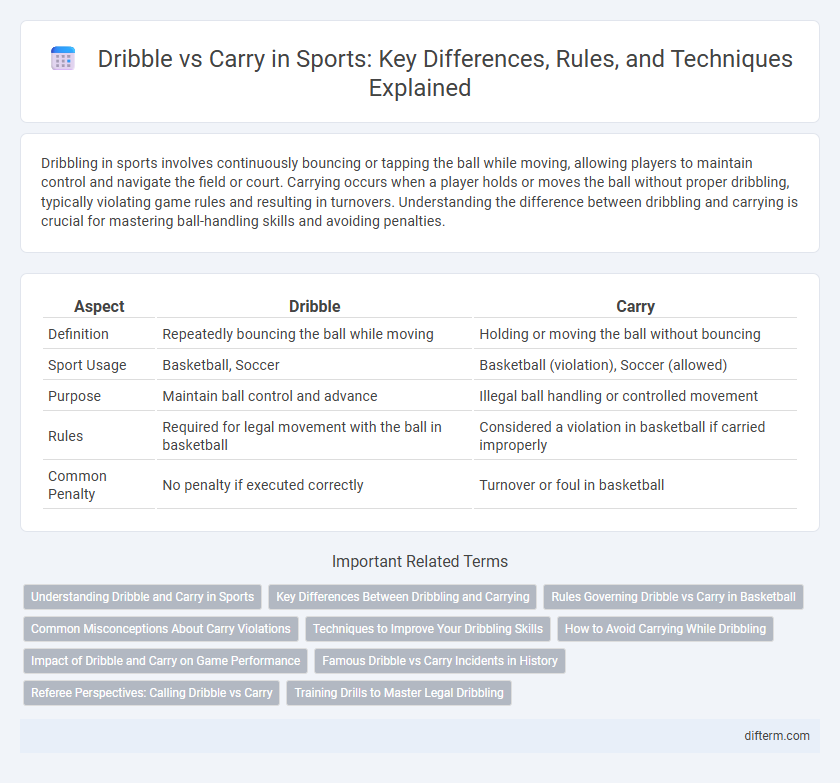Dribbling in sports involves continuously bouncing or tapping the ball while moving, allowing players to maintain control and navigate the field or court. Carrying occurs when a player holds or moves the ball without proper dribbling, typically violating game rules and resulting in turnovers. Understanding the difference between dribbling and carrying is crucial for mastering ball-handling skills and avoiding penalties.
Table of Comparison
| Aspect | Dribble | Carry |
|---|---|---|
| Definition | Repeatedly bouncing the ball while moving | Holding or moving the ball without bouncing |
| Sport Usage | Basketball, Soccer | Basketball (violation), Soccer (allowed) |
| Purpose | Maintain ball control and advance | Illegal ball handling or controlled movement |
| Rules | Required for legal movement with the ball in basketball | Considered a violation in basketball if carried improperly |
| Common Penalty | No penalty if executed correctly | Turnover or foul in basketball |
Understanding Dribble and Carry in Sports
Dribbling in sports like basketball and soccer refers to the controlled, continuous bouncing or tapping of the ball while moving, allowing players to maintain possession and create scoring opportunities. Carrying occurs when a player holds or palms the ball, violating the rules by temporarily stopping the dribble or gaining an unfair advantage in controlling the ball. Understanding the distinction between dribble and carry is crucial for players to avoid turnovers and ensure fair play during competitions.
Key Differences Between Dribbling and Carrying
Dribbling in sports like basketball involves continuously bouncing the ball with one hand while maintaining control, whereas carrying occurs when a player lets their hand slide underneath the ball, momentarily pausing or holding it, which violates ball-handling rules. The key difference lies in the legality of hand positioning and movement; dribbling requires an uninterrupted, rhythmic motion, while carrying disrupts this flow and grants an unfair advantage. Referees closely monitor hand placement and ball control to distinguish between legal dribbling and illegal carrying during gameplay.
Rules Governing Dribble vs Carry in Basketball
Rules governing dribble vs carry in basketball dictate that a legal dribble requires the player to continuously tap the ball with one hand while moving, without holding or palming it. Carrying occurs when the ball is momentarily held or turned over the hand, giving the player an unfair advantage by altering the ball's natural bounce. Officials enforce carrying violations to maintain fair play and ensure the fluidity of ball movement according to NBA and FIBA regulations.
Common Misconceptions About Carry Violations
A common misconception about carry violations is that a slight hand turn or momentary ball pause always results in a violation; however, referees typically consider the fluidity and intent of the dribble. Carry violations occur when a player's hand completely supports the ball underneath or when the ball comes to a continual rest, disrupting the normal dribbling motion. Understanding the distinction between a legal dribble and a carry is essential for players to avoid unnecessary turnovers and improve ball-handling efficiency.
Techniques to Improve Your Dribbling Skills
Mastering dribble techniques like controlled finger pads and low body posture enhances ball control and speed. Avoid carry violations by ensuring the ball doesn't rest or roll over the hand, focusing on consistent wrist flicks and hand positioning. Practicing varied dribble patterns and incorporating agility drills sharpens coordination and reaction time.
How to Avoid Carrying While Dribbling
Maintaining continuous hand contact with the basketball while dribbling can result in a carrying violation, which occurs when the ball is momentarily held or turned over the hand. To avoid carrying, players should ensure their hand stays on top or slightly on the side of the ball without cupping or scooping it during motion. Proper wrist flexion and controlled fingertip dribbling help maintain legal ball handling and improve overall dribbling efficiency.
Impact of Dribble and Carry on Game Performance
Dribbling enhances ball control and enables quick directional changes, directly impacting offensive strategies and creating scoring opportunities. Carrying the ball, when executed correctly within game rules, allows players to maintain possession while advancing, but improper carrying results in turnovers that disrupt team momentum. Effective mastery of dribbling and legal carries significantly influences overall game flow, player efficiency, and scoring potential in sports like basketball and soccer.
Famous Dribble vs Carry Incidents in History
The most famous dribble vs carry incident in sports history occurred during the 1993 NBA playoffs when Latrell Sprewell was called for a controversial carry, sparking debates over the interpretation of dribbling rules. In football, Diego Maradona's "Hand of God" goal is often cited as a carry-like incident because he handled the ball illegally before scoring, challenging the enforcement of ball control regulations. These incidents highlight the thin line between skillful ball handling and rule violations in professional sports, shaping discussions on officiating standards.
Referee Perspectives: Calling Dribble vs Carry
Referees distinguish a dribble from a carry by closely observing hand placement and ball control, ensuring the hand stays on top or side of the ball during a legal dribble. If the referee sees the player's hand come underneath the ball or the palm turning upward, it is typically called a carry violation. Consistent enforcement of these criteria helps maintain fair play and clarity in basketball officiating.
Training Drills to Master Legal Dribbling
Training drills to master legal dribbling focus on improving hand-eye coordination, ball control, and quick footwork. Cone drills, zig-zag dribbling exercises, and controlled pace variations help players maintain continuous, legal dribbling without carrying the ball. Consistent practice of these drills enhances muscle memory and reinforces proper wrist movement to avoid violations during gameplay.
dribble vs carry Infographic

 difterm.com
difterm.com